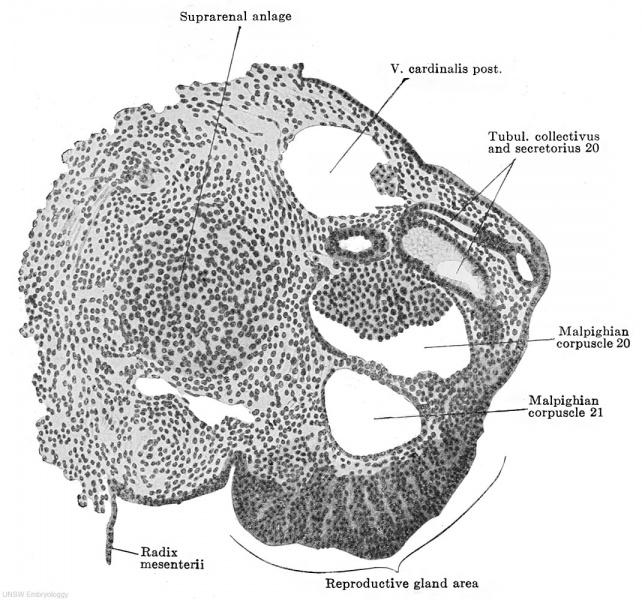File:Keibel Mall 2 613.jpg

Original file (1,070 × 1,000 pixels, file size: 236 KB, MIME type: image/jpeg)
Fig. 613. Transverse section of the urogenital fold of a human embryo of 11.0 mm greatest length
Embryo 9.0 mm. head-foot length. (Embryo P. 1, from the collection of Professor Hochstetter, Vienna.) X 150.
Almost all the parts of a mesonephric tubule are cut. Medial to the tubule is the suprarenal anlage; the mesonephric fold lies in the frontal plane, its summit is marked by the primary excretory duct and a dorsolateral and a ventral surface may be distinguished. At about the middle of the ventral surface is the thickening of the peritoneal epithelium which forms the reproductive gland area. ./This consists solely of ccelomic epithelial cells, which are becoming somewhat loosely arranged. No differentiation whatever of the epithelial mass is to be seen.
| Embryology - 27 Apr 2024 |
|---|
| Google Translate - select your language from the list shown below (this will open a new external page) |
|
العربية | català | 中文 | 中國傳統的 | français | Deutsche | עִברִית | हिंदी | bahasa Indonesia | italiano | 日本語 | 한국어 | မြန်မာ | Pilipino | Polskie | português | ਪੰਜਾਬੀ ਦੇ | Română | русский | Español | Swahili | Svensk | ไทย | Türkçe | اردو | ייִדיש | Tiếng Việt These external translations are automated and may not be accurate. (More? About Translations) |
Felix W. The development of the urinogenital organs. In Keibel F. and Mall FP. Manual of Human Embryology II. (1912) J. B. Lippincott Company, Philadelphia. pp 752-979.
| Historic Disclaimer - information about historic embryology pages |
|---|
| Pages where the terms "Historic" (textbooks, papers, people, recommendations) appear on this site, and sections within pages where this disclaimer appears, indicate that the content and scientific understanding are specific to the time of publication. This means that while some scientific descriptions are still accurate, the terminology and interpretation of the developmental mechanisms reflect the understanding at the time of original publication and those of the preceding periods, these terms, interpretations and recommendations may not reflect our current scientific understanding. (More? Embryology History | Historic Embryology Papers) |
Cite this page: Hill, M.A. (2024, April 27) Embryology Keibel Mall 2 613.jpg. Retrieved from https://embryology.med.unsw.edu.au/embryology/index.php/File:Keibel_Mall_2_613.jpg
- © Dr Mark Hill 2024, UNSW Embryology ISBN: 978 0 7334 2609 4 - UNSW CRICOS Provider Code No. 00098G
File history
Click on a date/time to view the file as it appeared at that time.
| Date/Time | Thumbnail | Dimensions | User | Comment | |
|---|---|---|---|---|---|
| current | 10:00, 20 February 2014 |  | 1,070 × 1,000 (236 KB) | Z8600021 (talk | contribs) | ==Fig. 613. Transverse section of the urogenital fold of a human embryo of 11.0 mm greatest length== Embryo 9.0 mm. head-foot length. (Embryo P. 1, from the collection of Professor Hochstetter, Vienna.) X 150. Almost all the parts of a mesonephric ... |
You cannot overwrite this file.
File usage
The following 2 pages use this file:
